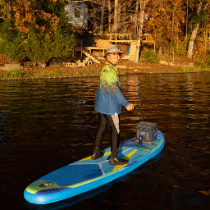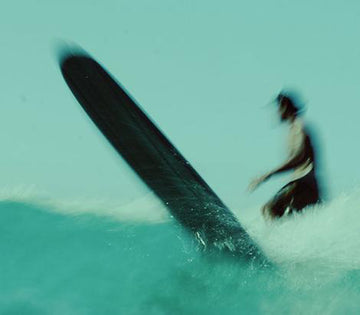Paddle board operation skills for Beginners
If you are paddling for the first time, it is best to choose calm water without boats and floating objects around. In the beginning, kneeling is easier than standing.
1.Standing on the board:
- Place the board in shallow water, stand next to the board, and insert the paddle into the water.
- Grasp the middle edge of the paddle with both hands, keeping the paddle in one hand at all times.
- Kneel to the middle and rear of the paddle, feel the balance point, the head of the paddle will not lift up, and the tail will not sink into the water
- Grasp one side of the paddle with your hand to stabilize it.
- When you are ready, stand up on one foot and kneel on your knees, or ask your friends to help you stand up with the paddle board.
2.Paddle position:
When you stand up, how do you balance on the paddle and start rowing?
- Stand with your feet parallel, stand in the middle of the paddle board, and stand with your feet against the edge of the paddle board.
- Keep your toes forward, knees bent, and back straight.
- Use the hips to maintain balance, keep the head and shoulders straight and stable, and use the hips to adjust the center of gravity.
- Look ahead, don't just stare at your feet.
- Like riding a bicycle, when you move forward, it is easier to balance.
3.Paddle Skills:
The balance on the paddle board is well mastered, and you can really enjoy the fun of rowing the paddle board.Here are some tips when paddling:
- When skating on the right, hold the lower part of the paddle with your right hand and the upper part of the paddle with your left hand.
- The curvature of the propeller head is facing away from you, and the opposite direction will slip left and right.
- Keep your arms straight and feel that you are paddling with your body, and your abdominal core strength plays a greater role than your arms.
- When paddling, push the upper handle forward with the upper hand.
- Insert the paddle into the water first, and then forcefully pull it down to the ankle to get out of the water.
- If you want to paddle straighter, the paddle is close to the edge of the paddle, and you can switch sides 4 or 5 times at the same time.
4.Cornering skills:
There are many easy ways to turn while rowing.
- Forward paddling control method: As the name implies, you can use the paddle to paddle on one side all the time to turn. Stroke to the left, the paddle board turns to the right, and the further the paddle is stroked, the greater the turn.
- Tail paddling method: You can use paddles to paddle in opposite directions on both sides of the tail to adjust the direction.
- Sweeping and paddling method: The longest distance of the paddle is extended to the front of the paddle board, vigorously paddling, and the paddle gradually draws a semi-circle shape from the head of the board to the tail of the board.
5.Falling water note:
Paddleboarding is actually very easy to learn, but it also requires a little preparation for the often unavoidable fall into the water.
- Ensure your own safety the first time you fall into the water, do not stay at the tail to avoid scratching the tail fin, and grab the handle from the middle of the paddle to get on the water.
- If your board and paddle leave you at the same time, grab the board first, then row the board to find the paddle. (A place where you can use the leg straps would be nice )










